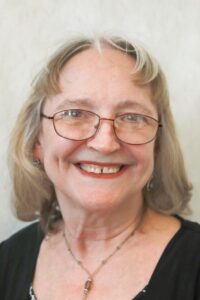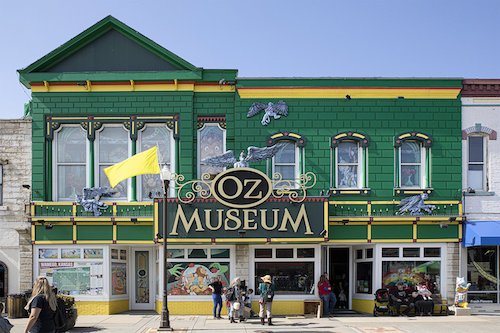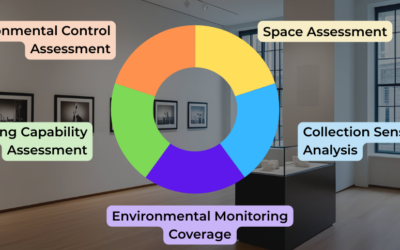At CONSERV we care about collections AND the people who care for collections. In this series of blogs we dive into the stories of some of our favorite customers, what brought them to their current place in their careers, and the unique ways they’re using Conserv. Today, we take a closer look at the OZ museum. (Banner image courtesy of tripadvisor.com)

Chris Glasgow, Curator of the OZ Museum in Kansas.
Chris Glasgow, Curator of the OZ Museum in Kansas, has always loved literature and history. Growing up, Chris moved around a lot, living in 28 different states. But she stayed grounded by being involved in theatre and through her interest in books.
“I think it probably started with my grandfather when I was a very young child. I just idolized my grandfather, and he was an avid, avid reader. He believed wholeheartedly in books regardless of the genre, and his gifts to me were always books. So I grew up with that culture of reading.”
“In college my focus was theatre arts, specifically children’s theatre, which of course led later to teaching theatre and literature.”
The connections between literature and history were obvious to Chris, and she strived to bring those relationships to life for her students.
“Every piece of literature has a history to it and is tied to the social, cultural, political history that the author comes from. So as part of teaching about literature I would incorporate all the backstories, the history. It all tied in together.”
When the economy took a turn and Chris needed to find a new role, she went on her own yellow brick road-style adventure.
“I took a road trip back and forth across the country for over a year, learning a lot about what was happening across the country at the time. I wound up here in Kansas. I walked into the OZ Museum to look around because it’s literature and film and theatre, and they offered me a job on the spot.”
The OZ Museum experience for a curator
Chris’s passion for telling the story of Oz is clear.
“We’re covering the entire history of the Oz phenomenon from the childhood of the author to today. We have items from the author and his family, things from early radio shows, early stage productions, the original books, of course the 1939 film, Broadway productions, and other films. We cover the whole gamut.”
However, as a new curator herself, Chris had a bit of a learning curve when it came to figuring out all the ins and outs of museums.
She found community through the American Association for State and Local History (AASLH) and the Kansas Museum Association (KMA). Chris recently completed AASLH’s Small Museum Pro! Certificate and is an active participant in the AASLH and KMA online forums.
“That really helps a lot if I have a question or something I’m not sure about, procedures, or whatnot. I can get advice from other professionals in the field.”
Chris also enjoys attending museum conferences, both in person and virtually.
“It’s been nice to network with people, meet people I’ve talked with on the phone or online, ask questions. That’s been very valuable.”
And that is where she was first introduced to the team at Conserv.
“I saw the Conserv vendor at one of the virtual conferences, and I went on the website and learned more about it. A colleague then recommended we check Conserv out, and I had already talked with them online. So that was a nice segue.”
Environmental monitoring for a magical collection
“Lions, and tigers, and bears! Oh, my!” How do you take care of such a varied collection?
The OZ Museum is located in a beautiful 1870s building, which comes with a particular set of challenges familiar to many small museum professionals.
“Before I came on as a curator, the OZ Museum had not had a curator for a long time. So there was no one handling all the artifacts, the displays, no one handling things like cleaning, repairing, making sure things were preserved properly, stored properly. The building that we’re in for the OZ Museum, other than the level where the museum is, has no environmental control.”
Chris describes how the OZ Museum’s prior environmental monitoring was pretty limited.
“They had one portable handheld data monitor, which told temperature and humidity, and since we have three storage areas, it was constantly being moved from place to place just to give them an idea of what the conditions were. So there was no consistent monitoring at all.”
Small museums often come with small budgets and endless competing priorities.
“I had [environmental monitoring] on my wish list in my budget. But it wasn’t considered a high priority since no one really knew what was going on. Since we had no accurate monitoring, I had no consistent data to justify purchasing the equipment that we needed to be able to monitor. That was the biggest problem. There wasn’t the compelling evidence to show that this was necessary for preservation.”
Chris and the OZ Museum recently qualified for the Collections Assessment for Preservation (CAP) Program through the Institute for Museum and Library Services. This program supports small museums in developing a plan for collections care. As part of the assessment phase, one of the OZ Museum’s program assessors recommended that Chris connect with Conserv to see how they could support some initial baseline environmental monitoring.
Conserv and the OZ Museum: “A horse of a different color”
Conserv helped solve a lot of Chris’s problems. She shared, “I was recording daily readings in a handwritten spreadsheet and trying to translate that in my reports to the board.”
Conserv made all of that automatic.
“Once I started working with the program, I realized, whoa, wait a minute, I don’t have to figure out the data. They do it for me. It’s not just once a week or when I have time to check the data. It’s ongoing. I can go in at any time of the day, as many times as I want to see the fluctuations in temperature, humidity, light. I had not seen any of the other programs that were quite that comprehensive.”
Along with immediate access to the data, Chris loves that Conserv’s weekly reports help her keep leadership informed about the safety of the collections.
“When Conserv started to do weekly summary reports, that was very helpful for my weekly reports to my Executive Director. If there was a major change, I could point those out to him. I liked the fact that it kept me better informed as to what was going on.”
The data and reports from Conserv have been an invaluable tool for Chris to advocate for additional collections care resources.
“The board could actually see what was going on, which, of course, opened eyes, and people began realizing, ‘Whoa, we need to do something.’ We’re hoping that the data we’ve been able to collect and present to the board and possible investors will be compelling enough that we can get support when the time comes.”
Conserv’s monitoring empowers Chris with the data she needs to keep the OZ Museum collections safe and vibrant for generations of visitors who venture “somewhere over the rainbow” to enjoy.
If you have any questions about environmental monitoring, integrated pest management, or just want to talk about preventative conservation, please reach out to us! Don’t forget to check out our blog or join our community of collections care professionals where you can discuss hot topics, connect with other conservators or even take a course to get familiar with the Conserv platform.




